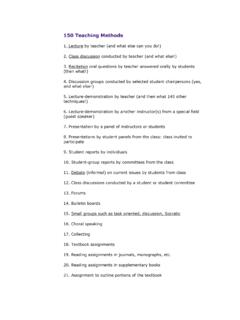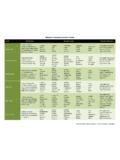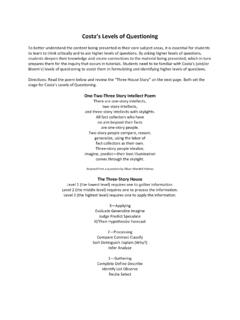Transcription of Bloom's Taxonomy of Educational Objectives
1 Bloom's Taxonomy of Educational ObjectivesOne of the most widely used ways of organizing levels of expertise is according toBloom's Taxonomy of Educational Bloom's Taxonomy (Tables 1-3) usesa multi-tiered scale to express the level of expertise required to achieve eachmeasurable student outcome. Organizing measurable student outcomes in this waywill allow us to select appropriate classroom assessment techniques for the are three taxonomies. Which of the three to use for a given measurablestudent outcome depends upon the original goal to which the measurable studentoutcome is connected. There are knowledge-based goals, skills-based goals, andaffective goals (affective: values, attitudes, and interests); accordingly, there is ataxonomy for each. Within each Taxonomy , levels of expertise are listed in order ofincreasing complexity.
2 Measurable student outcomes that require the higher levelsof expertise will require more sophisticated classroom assessment course goal in Figure 2--"student understands proper dental hygiene"--is anexample of a knowledge-based goal. It is knowledge-based because it requires thatthe student learn certain facts and concepts. An example of a skills-based goal forthis course might be "student flosses teeth properly." This is a skills-based goalbecause it requires that the student learn how to do something. Finally, an affectivegoal for this course might be "student cares about proper oral hygiene." This is anaffective goal because it requires that the student's values, attitudes, or interests beaffected by the 1: Bloom's Taxonomy of Educational Objectives for Knowledge-Based GoalsLevel of ExpertiseDescription of LevelExample of MeasurableStudent Outcome1.
3 Knowledge Recall, or recognition of terms,ideas, procedure, theories, etc. When is the first day ofSpring?2. Comprehension Translate, interpret,extrapolate, but not see fullimplications or transfer to othersituations, closer to literaltranslation. What does the summersolstice represent?3. Application Apply abstractions, generalprinciples, or methods tospecific concrete situations. What would Earth'sseasons be like if its orbitwas perfectly circular?4. Analysis Separation of a complex ideainto its constituent parts and anunderstanding of organizationand relationship between theparts. Includes realizing thedistinction between hypothesisand fact as well as betweenrelevant and extraneousvariables. Why are seasons reversedin the southernhemisphere?5. Synthesis Creative, mental construction ofideas and concepts frommultiple sources to formcomplex ideas into a new,integrated, and meaningfulpattern subject to givenconstraints.
4 If the longest day of theyear is in June, why is thenorthern hemispherehottest in August?pattern subject to EvaluationTo make a judgment of ideas ormethods using externalevidence or self-selected criteriasubstantiated by observationsor informed would be theimportant variables forpredicting seasons on anewly discovered planet?Table 2: Bloom's Taxonomy of Educational Objectives for Skills-Based GoalsLevel of ExpertiseDescription of LevelExample of MeasurableStudent OutcomePerceptionUses sensory cues to guideactionsSome of the coloredsamples you see will needdilution before you taketheir spectra. Using onlyobservation, how will youdecide which solutionsmight need to be diluted?SetDemonstrates a readiness totake action to perform the taskor objectiveDescribe how you wouldgo about taking theabsorbance spectra of asample of pigments?
5 Guided ResponseKnows steps required tocomplete the task or objectiveDetermine the density of agroup of sample metalswith regular and task or objective in asomewhat confident, proficient,and habitual mannerUsing the proceduredescribed below,determine the quantity ofcopper in your unknownore. Report its meanvalue and OvertResponsePerforms task or objective in aconfident, proficient, andhabitual mannerUse titration to determinethe Ka for an unknownweak task or objective asabove, but can also modifyactions to account for new orproblematic situationsYou are performingtitrations on a series ofunknown acids and find avariety of problems withthe resulting curves, ,only ml of base isrequired for one acid ml is required inanother. What can you doto get valid data for all theunknown acids?OrganizationCreates new tasks or objectivesincorporating learned onesRecall your plating andetching experiences withan aluminum a different metalsubstrate and design aprocess to plate, mask,and etch so that a patternof 4 different metals and design aprocess to plate, mask,and etch so that a patternof 4 different metals 3: Bloom's Taxonomy of Educational Objectives for Affective GoalsLevel of ExpertiseDescription of LevelExample of MeasurableStudent OutcomeReceivingDemonstrates a willingness toparticipate in the activityWhen I'm in class I amattentive to the instructor,take notes, etc.
6 I do notread the interest in the objects,phenomena, or activity byseeking it out or pursuing it forpleasureI complete my homeworkand participate in an appreciation for(values) the Objectives ,phenomena, or activityI seek out information inpopular media related tomy to compare differentvalues, and resolves conflictsbetween them to form aninternally consistent system ofvaluesSome of the ideas I'velearned in my class differfrom my previous do I resolve this?Characterizationby a Value orValue ComplexAdopts a long-term valuesystem that is "pervasive,consistent, and predictable"I've decided to take myfamily on a vacation tovisit some of the places Ilearned about in my determine the level of expertise required for each measurable student outcome,first decide which of these three broad categories (knowledge-based, skills-based,and affective) the corresponding course goal belongs to.
7 Then, using the appropriateBloom's Taxonomy , look over the descriptions of the various levels of which description most closely matches that measurable studentoutcome. As can be seen from the examples given in the three Tables, there aredifferent ways of representing measurable student outcomes, , as statementsabout students (Figure 2), as questions to be asked of students (Tables 1 and 2), oras statements from the student's perspective (Table 3). You may find additionalways of representing measurable student outcomes; those listed in Figure 2 and inTables 1-3 are just 's Taxonomy is a convenient way to describe the degree to which we want ourstudents to understand and use concepts, to demonstrate particular skills, and tohave their values, attitudes, and interests affected. It is critical that we determinethe levels of student expertise that we are expecting our students to achievebecause this will determine which classroom assessment techniques are mostappropriate for the course.
8 Though the most common form of classroom assessmentused in introductory college courses--multiple choice tests--might be quite adequatefor assessing knowledge and comprehension ( levels 1 and 2, Table 1), this type ofassessment often falls short when we want to assess our students knowledge at thehigher levels of synthesis and evaluation ( levels 5 and 6).4 Multiple-choice tests also rarely provide information about achievement of skills-based goals. Similarly, traditional course evaluations, a technique commonly usedfor affective assessment, do not generally provide useful information about changesin student values, attitudes, and , commonly used assessment techniques, while perhaps providing a means forassigning grades, often do not provide us (or our students) with useful feedback fordetermining whether students are attaining our course goals.
9 Usually, this is due toa combination of not having formalized goals to begin with, not having translatedthose goals into outcomes that are measurable, and not using assessmenttechniques capable of measuring expected student outcomes given the levels ofexpertise required to achieve them. Using the CIA model of course development, wecan ensure that our curriculum, instructional methods, and classroom assessmenttechniques are properly aligned with course that Bloom's Taxonomy need not be applied exclusively after course goals havebeen defined. Indeed, Bloom's Taxonomy and the words associated with its differentcategories can help in the goals-defining process itself. Thus, Bloom's Taxonomy canbe used in an iterative fashion to first state and then refine course goals. bloom 'sTaxonomy can finally be used to identify which classroom assessment techniques aremost appropriate for measuring these goals.



